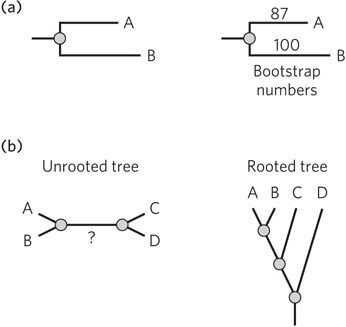
Time depictions and rootedness in phylogenetic trees. (a) The length of tree branches can be meaningless or, if specified, can represent some unit of evolutionary time. For example, the relative lengths of the branches correspond to differences in a time measure leading to taxa A and B. When numbers are given (right), these indicate the investigator’s confidence in the information in that branch, based on statistical tests; the numbers here are typical of the common bootstrap analysis. (b) In an unrooted tree, some of the relationships between taxa may be evident, but there is uncertainty about the common ancestor of all the taxa. In a rooted tree, all taxa can be traced to a common ancestor.